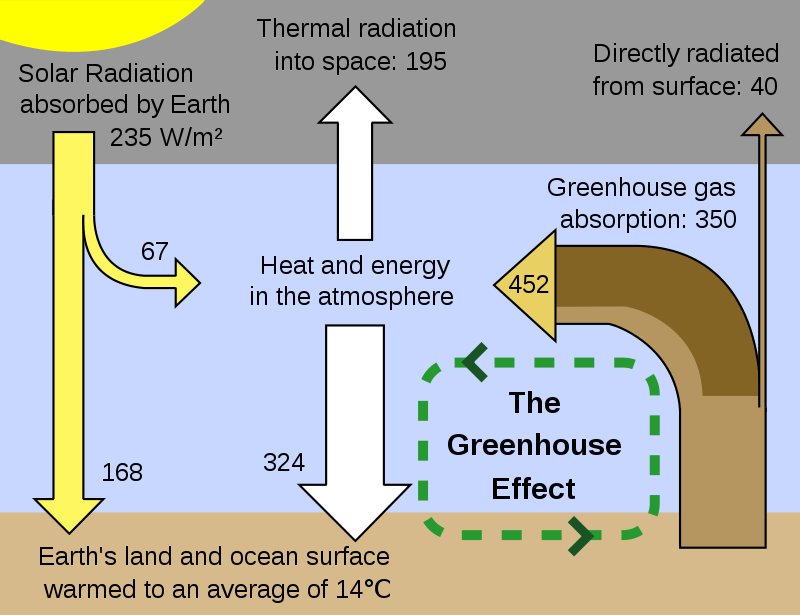
Definition of Greenhouse Effect
Greenhouse effect – the phenomenon of increasing the temperature of a planet by greenhouse gases present in its atmosphere (compared to the situation in which there would be no greenhouse gases). Changes causing an increase in the intensity of the greenhouse effect are the main cause of the global warming observed on Earth.
A celestial body without an atmosphere (eg the moon) absorbs and emits radiation directly from its surface. The atmosphere disrupts this heat transfer process, mainly by limiting the amount of heat radiated from the planet’s surface and its lower atmosphere directly into space. This effect is caused by greenhouse gases and to a lesser extent by dust and aerosols suspended in the atmosphere. The description of the energy balance of the planet, apart from the greenhouse effect, also takes into account all other processes taking place in the atmosphere and on the planet’s surface, responsible for the energy flow from the host star, as well as transferring energy from the planet to space. In the Solar System, the greenhouse effect has been found on Earth, Mars, Venus, and Saturn’s moon Titan.
The mechanism of the Effect of Greenhouse

Heat balance
The Earth and its atmosphere, like any other planet, are surrounded by an almost vacuum. Therefore the exchange of thermal energy with the environment takes place almost exclusively through electromagnetic radiation. The most important for the Earth’s energy balance is the amount of solar radiation reaching it. Other types of energy that convert to heat and heat the Earth’s surface are less important than solar radiation energy.
The Earth not only receives but also gives off thermal energy in the form of thermal radiation. The amount of which depends on the planet’s temperature.
Energy Balance at the top of the atmosphere
A tremendous amount of energy in the form of solar radiation flows from outer space to the Earth-atmosphere system. The radiation flux reaching the upper atmosphere is approximately 1366 W / square meter of the surface perpendicular to the radiation (it is the so-called solar constant ). Taking into account the spherical shape of the Earth. This corresponds to about 342 W / m² of the Earth’s surface and a power of 1.74 • 10 17 watts supplied on average to the entire planet.
The spectrum of solar radiation is similar to that of a black body at 5250 ° C. Most of the energy of solar radiation falls into visible light and near-infrared light. To this extent, the pure atmosphere of the Earth is almost transparent.
Solar radiation is partially reflected. The albedo of the Earth as observed from space (at the top of the atmosphere) is approximately 31% (107 W / m²). The atmosphere (clouds, dust, and gases) reflects 22% (77 W / m²) and 9% (30 W / m²) surface of the earth.
Energy balance on the Earth’s surface
The earth, like anybody, emits thermal radiation. This radiation has a distribution similar to that of a black body at the temperature of 287 K. The surface of the Earth is much cooler than the surface of the Sun (287 K vs 5780 K). It radiates thermal energy in waves of greater length than the wavelengths reaching the Earth (and heating I). The intensity of solar radiation, according to Wien’s law, has a maximum in visible radiation (about 0.5 μm ). The thermal radiation of the Earth in the far infrared (about 10 μm).
For radiation emitted by the Earth’s surface, the Earth’s atmosphere is opaque and absorbs most of it. Thereby heating it. The absorbed energy is radiated both toward the Earth and toward the cosmos. The energy sent to the Earth is significant (324 W / m²). Almost twice the power provided by the Sun (168 W / m²). As a result of the radiation of the atmosphere towards the Earth, the temperature of its surface increases. Increasing its emission of thermal radiation leads to an increase in the temperature of the atmosphere. The processes of absorption and emission of energy are in equilibrium. Which determines the average temperature of the Earth’s surface and the atmosphere.
Atmospheric energy balance and Effect of Greenhouse
The flow of energy from the Earth’s surface upwards into the atmosphere is caused by several phenomena. Such as the direct flow of radiation in the atmospheric window, absorption, and emission of thermal radiation, convection, as well as water evaporation and condensation. The energy transfer process is described by the radiation transport equation. In simplified models and to illustrate the role of individual phenomena. The energy balance for the atmosphere as a whole is considered.
The upper layers of the atmosphere emit thermal energy into space (approx. 195 W / m²), and the lower layers towards the Earth (approx. 324 W / m²). Such a significant emission would lower the temperature of the atmosphere by about 1.6 ° C per day. However, this process is balanced due to the absorption of solar radiation (67 W / m²). Energy input from the lower atmosphere by radiation (350 W / m²), convection (24 W / m²), and condensation of water vapor (78 W / m²).




Very nice